
Creating the Perfect Sleep Environment for Your Baby
Share
Creating the perfect sleep environment for your baby can make a big difference in how well they rest and grow. Research shows that a few key elements—room temperature, lighting, and sound—play a powerful role in promoting better, more restful sleep for babies. Here’s how to set the stage for sweet dreams, backed by science.
Room Temperature: Keep It Cool and Comfortable
Babies sleep best in a space that’s comfortably cool—between 68°F and 72°F is ideal. According to the American Academy of Pediatrics (AAP), overheating is a known risk factor for Sudden Infant Death Syndrome (SIDS), so keeping the nursery on the cooler side is important. A room thermometer can help you monitor the temperature, and lightweight, breathable pajamas (like ours!) keep your baby cozy without too many layers.
Lighting: Dim Lights Signal It’s Time to Sleep
Babies’ internal clocks are still developing, and lighting has a big impact on their circadian rhythms. Exposure to bright or blue-toned light before bedtime can interfere with melatonin production, making it harder for your baby to fall asleep. Use blackout curtains to darken the room during naps and bedtime, and if you need a light for middle-of-the-night feedings or diaper changes, opt for a warm red or amber nightlight to avoid disrupting their sleep hormones.
Sound: Use White Noise or Gentle Sounds
Complete silence isn’t always the best environment for sleep—especially when background noise from the household can wake a baby. White noise machines that mimic the sound of the womb or nature can help babies fall asleep faster and stay asleep longer. Studies show that white noise significantly reduces crying and encourages more restful sleep. Just be sure to keep the volume below 50 decibels, which is the safe level for your baby’s developing hearing.
Other Tips for Better Sleep
Create a consistent bedtime routine so your baby knows what to expect each night—this helps signal their body that it’s time to rest. Use a firm mattress with a fitted sheet and no loose blankets, pillows, or toys in the crib, following AAP safe sleep guidelines. Keep the room well-ventilated, but avoid placing the crib in the path of direct air flow from fans or vents. The right combination of comfort and routine makes all the difference.
Final Thoughts
Every baby is different, so it may take some observation and gentle tweaks to find what works best for your little one. With the right sleep environment—comfortable temperature, dim lighting, and calming sound—you’re giving your baby the foundation for healthy sleep habits that will benefit the whole family.
References
-
American Academy of Pediatrics Task Force on Sudden Infant Death Syndrome. (2016). SIDS and Other Sleep-Related Infant Deaths: Updated 2016 Recommendations for a Safe Infant Sleeping Environment. Pediatrics, 138(5). https://doi.org/10.1542/peds.2016-2940
-
Hiscock, H., & Wake, M. (2002). Randomized controlled trial of behavioral infant sleep intervention to improve infant sleep and maternal mood. Pediatrics, 109(6), e105.
-
Okamoto-Mizuno, K., & Mizuno, T. (2012). Effects of thermal environment on sleep and circadian rhythm. Journal of Physiological Anthropology, 31(1), 14.
-
Spencer, J. A., Moran, D. J., Lee, A., & Talbert, D. (1990). White noise and sleep induction. Pediatrics, 85(5), 874-878.
- Cajochen, C. (2011). Alerting effects of light. Sleep Medicine Reviews, 11(6), 453-464.
